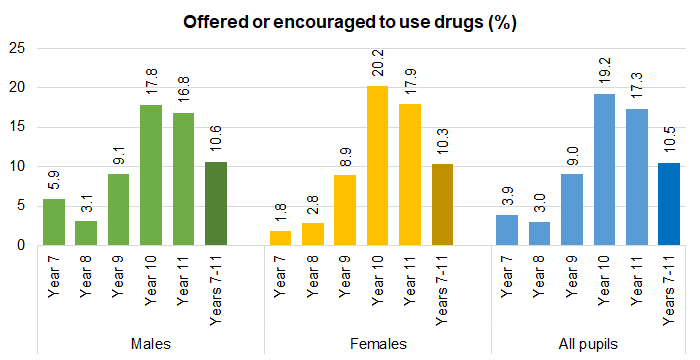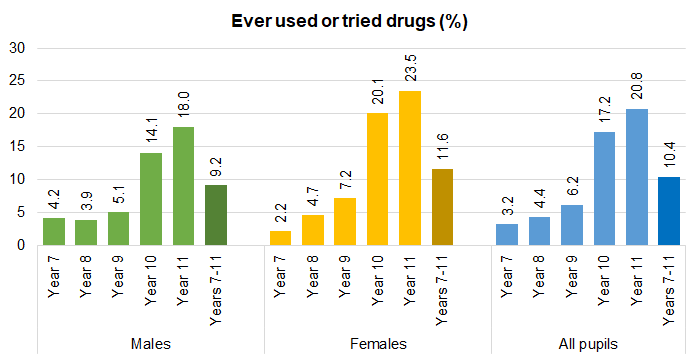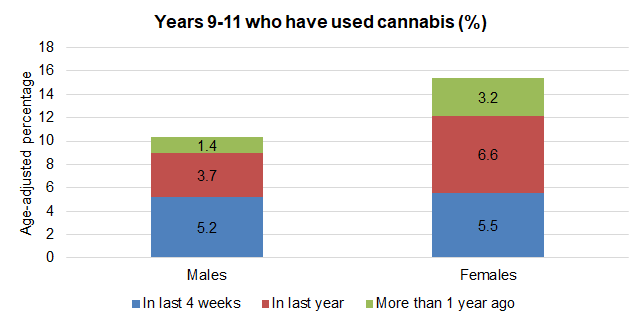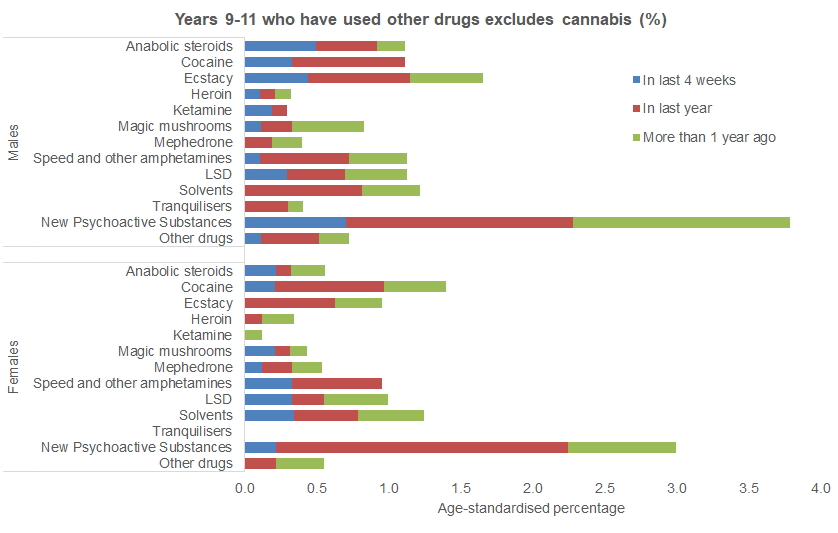Index
This topic area covers statistics and information relating to substance use among young people in Hull including local strategic need and service provision. Further information relating to Drug Use Among Adults is given under Lifestyle Factors within Adults. Substance use information has been collected within Hull’s Health and Wellbeing Surveys and full reports are available under Surveys within Tools and Resources.
This page contains information from the Office for Health Improvement & Disparities’ Fingertips. Information is taken ‘live’ from the site so uses the latest available data from Fingertips and displays it on this page. As a result, some comments on this page may relate to an earlier period of time until this page is next updated (see review dates at the end of this page).
Headlines
- Different illicit drugs and prescribed medication have different effects on physical and mental health, and some are highly addictive. Substance use can have a serious impact not just on the individual, but also their family and friends, and there is a detrimental effect on the entire community.
- Among people aged 15-64 years, it is estimated that there are around twice as many opiate and/or crack users in Hull compared to England. Mortality rates from drug use are also higher in Hull being around 50% higher than England. As rates are higher among Hull adults, it is also probable that they are also higher among young people.
- In Hull’s Young People Health and Wellbeing Survey conducted during 2016, among year 7 and 8 secondary school pupils (aged 11-13 years), fewer than 5% had been offered or encouraged to use drugs in the last three months. Just under one in ten of year 9 pupils (aged 13-14 years) had also been offered or encouraged to use drugs in the last three months but this increased to just under 20% among year 10 and 11 pupils (aged 14-16 years).
- In the 2016 survey, fewer than 5% of year 7 and 8 pupils had ever used or tried drugs. Around 6% of year 9 pupils, 17% of year 10 and 21% of year 11 pupils, although the percentages were higher for females compared to males with the exception of year 7 children.
- In 2016, among pupils in school years 9 to 11, cannabis was by far the most common drug that they reported having used, with 15% of girls and 10% of boys stating they had used it at some point including 5.5% of girls and 5.2% of boys having done so in the last four weeks. The most commonly used drug after cannabis was New Psychoactive Substances used by 3% of girls and almost 4% of boys. A further 1% or more of pupils also reported using solvents (boys and girls), LSD (boys), speed and other amphetamines (boys), ecstasy (boys), cocaine (boys and girls) and anabolic steroids (boys).
- Among young people aged 15 to 24 years in Hull, there were an average of 20 hospital admissions for substance use per year for the three year period 2020/21 to 2022/23. The directly standardised admission rate was 59 per 100,000 population which was similar to England. There has been a sharp decline in the admission rate in Hull since the peak of 156 admissions per 100,000 population for the three year period 2013/14 to 2015/16.
- There were seven drug poisoning deaths among Hull residents aged under 25 years that were registered during the three year period 2022 to 2024.
The Population Affected – Why Is It Important?
Different illicit drugs and prescribed medication have different effects on physical and mental health, and some are highly addictive. From the NHS, the health risks for illicit drugs and substance use include death from an overdose, lung disease from smoking drugs, HIV or viral hepatitis, serious infections in the body and bloodstream, fertility problems, damage to veins and body tissue through injecting drugs, overheating and dehydration, kidney problems, schizophrenia, hallucinatory states, insomnia, fits, agitation, aggression, confusion, paranoia, psychosis, memory problems, depression, anxiety and lack of concentration. It can also be dangerous to drive after taking drugs, increasing the risk of an accident.
Substance use can have a serious impact not just on the individual, but also their family and friends who may require considerable support. There also can be a detrimental effect on the entire community. Individuals dependent on opioids and/or crack cocaine are responsible for an estimated 45% of acquisitive crime (shoplifting, burglary, vehicle crime and robbery).
The Hull Picture
Prevalence
From the local Young People Health and Wellbeing Survey conducted in 2016, fewer than 5% of secondary school pupils year 7 and 8 (aged 11-12 and 12-13 years) had been offered or encouraged to use drugs in the last three months. Just under one in ten of year 9 pupils had also been offered or encouraged to use drugs in the last three months but this increased to just under 20% among year 10 and 11 pupils. Among older pupils, slightly more females had been offered or encouraged to use drugs recently compared to males.

There was a slight difference among young people based on where they lived. The age-adjusted percentage was highest among young people living in the most deprived fifth of areas of Hull (18.1%) falling to 14.2% and 12.4% for the second most deprived and middle fifths respectively, before increasing for young people living in the second least deprived fifth (16.0%) and least deprived fifth (14.8%) of areas of Hull.
Young people were also asked if they had ever used or tried drugs, as well as the type of drug they had used or tried, and when they had last used or tried them. Fewer than 5% of year 7 and 8 pupils had ever used or tried drugs. Around 6% of year 9 pupils, 17% of year 10 and 21% of year 11 pupils, although the percentages were higher for females compared to males with the exception of year 7 children.

Young people living in the most deprived areas of Hull were more likely to have ever used or tried drugs being 18.6% among young people living in the most deprived fifth of areas of Hull falling to 16.1% among those living in the second most deprived fifth of areas of Hull. The percentages further fell consistently across the other three groups but were more similar at 12.9%, 12.3% and 12.0% for the middle, second least and least deprived fifths of areas of Hull respectively.
Among pupils in school years 9 to 11, cannabis was by far the most common drug that they reported having used, with 15% of girls and 10% of boys stating they had used it at some point including 5.5% of girls and 5.2% of boys having done so in the last four weeks.

The most commonly used drug after cannabis was New Psychoactive Substances used by 3% of girls and almost 4% of boys. These were terms ‘legal highs’ in the questionnaire as this is what they were known as at the time, but they are no longer legal and are now correctly termed as New Psychoactive Substances. A further 1% or more of pupils also reported using solvents (boys and girls), LSD (boys), speed and other amphetamines (boys), ecstasy (boys), cocaine (boys and girls) and anabolic steroids (boys).

Hospital Admissions
The Office for Health Improvement & Disparities’ Fingertips provides information on hospital admissions due to substance use among young people aged 15-24 years with a directly standardised rate (standardised to the European Standard Population).
The rate in Hull for the three year period 2021/22-2023/24 was higher than England although the difference was not statistically significant.
Compared with benchmark
| Indicator | Period | England | Yorkshire and the Humber region (statistical) | Kingston upon Hull | East Riding of Yorkshire | North East Lincolnshire | North Lincolnshire | York | North Yorkshire UA | Barnsley | Doncaster | Rotherham | Sheffield | Bradford | Calderdale | Kirklees | Leeds | Wakefield |
|---|---|---|---|---|---|---|---|---|---|---|---|---|---|---|---|---|---|---|
Hospital admissions due to substance misuse (15 to 24 years) (Persons 15-24 yrs) | 2021/22 - 23/24 | 47.4 | 36.6 | 57.7 | 37.5 | 48.2 | 42.6 | 26.5 | 19.7 | 94.0 | 59.5 | 47.9 | 22.2 | 37.8 | 45.8 | 38.0 | 25.1 | 49.2 |
| Indicator | Period | England | Yorkshire and the Humber region (statistical) | Kingston upon Hull | East Riding of Yorkshire | North East Lincolnshire | North Lincolnshire | York | North Yorkshire UA | Barnsley | Doncaster | Rotherham | Sheffield | Bradford | Calderdale | Kirklees | Leeds | Wakefield |
|---|---|---|---|---|---|---|---|---|---|---|---|---|---|---|---|---|---|---|
Hospital admissions due to substance misuse (15 to 24 years) (Persons 15-24 yrs) | 2021/22 - 23/24 | 47.4 | 36.6 | 57.7 | 37.5 | 48.2 | 42.6 | 26.5 | 19.7 | 94.0 | 59.5 | 47.9 | 22.2 | 37.8 | 45.8 | 38.0 | 25.1 | 49.2 |
The standardised hospital admission rate due to substance use has increased from 85 admissions per 100,000 population in 2008/09-2010/11 to a high of 156 admissions per 100,000 population in 2013/14-2015/16. The rate decreased then decreased to around 130-140 admissions per 100,000 population for the next four years to 2017/18-2019/20.
The rates have subsequently decreased even further although it is possible that the initial decrease was impacted by the COVID-19 pandemic (the first lockdown commenced March 2020). The admission rate has continued to decrease in Hull and the admission rate in the latest three year period 2021/22-2023/24 is the lowest it has been for 14 years.
Over the three year period 2021/22-2023/24, there were 60 substance related admissions among 15-24 year olds in Hull equating to an average of 20 each year.
The admission rate over the 11-year period 2008/09-2010/11 to 2018/19-2020/21 has been statistically significantly higher in Hull compared to England, but in the last three years there is no statistically significant difference in the admission rate between Hull and England.
Compared with benchmark
Hospital admissions due to substance misuse (15 to 24 years) (Persons 15-24 yrs)
|
Period
|
Kingston upon Hull |
Yorkshire and the Humber region (statistical)
|
England
|
||||
|---|---|---|---|---|---|---|---|
|
Count
|
Value
|
95%
Lower CI |
95%
Upper CI |
||||
| 2008/09 - 10/11 | • | 117 | 84.9 | 71.2 | 103.2 | 67.9 | 63.5 |
| 2009/10 - 11/12 | • | 156 | 116.5 | 98.6 | 136.6 | 80.7 | 69.4 |
| 2010/11 - 12/13 | • | 170 | 136.8 | 117.0 | 159.0 | 89.2 | 76.5 |
| 2011/12 - 13/14 | • | 175 | 142.5 | 122.0 | 165.4 | 92.5 | 82.7 |
| 2012/13 - 14/15 | • | 175 | 144.8 | 123.8 | 168.3 | 95.4 | 90.3 |
| 2013/14 - 15/16 | • | 180 | 155.9 | 133.7 | 180.6 | 98.9 | 94.9 |
| 2014/15 - 16/17 | • | 160 | 137.8 | 116.8 | 161.4 | 93.8 | 91.0 |
| 2015/16 - 17/18 | • | 155 | 136.3 | 115.4 | 159.8 | 88.5 | 87.2 |
| 2016/17 - 18/19 | • | 150 | 130.6 | 110.2 | 153.7 | 84.9 | 83.8 |
| 2017/18 - 19/20 | • | 145 | 130.5 | 109.9 | 153.7 | 85.0 | 83.8 |
| 2018/19 - 20/21 | • | 120 | 110.8 | 91.8 | 132.5 | 78.6 | 80.5 |
| 2019/20 - 21/22 | • | 90 | 81.2 | 65.1 | 100.2 | 63.4 | 71.0 |
| 2020/21 - 22/23 | • | 60 | 58.9 | 45.1 | 75.5 | 46.7 | 58.3 |
| 2021/22 - 23/24 | • | 60 | 57.7 | 44.1 | 74.3 | 36.6 | 47.4 |
Source: OHID, based on NHS England and Office for National Statistics data
From local analysis, it is possible to examine these admissions in more detail (numbers might not add up as rounded to nearest five). The figures are slightly different for the local analysis with 120 admissions in total among those aged 15-24 years over the three year period 2018/19 to 2020/21.
There were a further 20 admissions among children and young people aged under 15 years over the same period in Hull. There were more drug-related hospital admissions among males compared to females over the three year period 2018/19 to 2020/21, although among those aged under 18 years and under 20 years, there were only small differences in the total number of admissions.
| Age | 2018/19 to 2020/21 Males (N) | 2018/19 to 2020/21 Females (N) | 2018/19 to 2020/21 Persons (N) |
| 0-14 | 10 | 10 | 20 |
| 15-17 | 10 | 10 | 20 |
| 18-19 | 10 | 10 | 20 |
| 20-21 | 15 | 5 | 25 |
| 22-24 | 40 | 15 | 55 |
| Total | 85 | 55 | 140 |
| Under 18 | 20 | 20 | 40 |
| Under 20 | 30 | 30 | 60 |
| 15-24 | 75 | 45 | 120 |
It is also possible to examine admissions for a more recent period using the local data. There were fewer drug-related hospital admissions among children and young people over the three year period 2020/21 to 2022/23, but this could be partially due to a reduction in hospital admissions overall due to the COVID-19 pandemic. It is necessary to combine some of the age groups as the numbers are too small for some age groups.
Overall, for the three year period 2020/21 to 2022/23, the total number of drug-related hospital admissions among those aged 15-24 years was half that recorded for the three year period 2018/19 to 2020/21.
| Age | 2020/21 to 2022/23 Males (N) | 2020/21 to 2022/23 Females (N) | 2020/21 to 2022/23 Persons (N) |
| 0-14 | 5 | 5 | 10 |
| 15-19 | 10 | 10 | 20 |
| 20-24 | 25 | 15 | 40 |
| Total | 40 | 30 | 70 |
| Under 20 | 15 | 15 | 30 |
| 15-24 | 35 | 25 | 60 |
Mortality
There were seven deaths among children and young people aged under 25 years from drug poisoning that were registered during the three year period 2022 to 2024.
Strategic Need and Service Provision
The Government’s 10-year Drugs Plan has three overarching aims to (1) Break drug supply chains, (2) Deliver world-class treatment and recovery services and (3) Achieve a shift in the demand for recreational drugs.
The 10-Year Drugs Plan expects to reverse the rising trend in drug use, prevent drug deaths and expand treatment capacity. The document recognises the need to support young people and families most at risk of substance use and commits to invest in a range of programmes that provide early, targeted and specialist support to children, young people and families. The Government also commits to invest in the education and resilience of children and young people to help level up the whole country, and acknowledges that the most effective and sustainable approach to reducing harm is building resilience of young people through giving them a good start in life, the best education possible and keeping them safe, well and happy.
Hull’s Alcohol and Drugs Partnership Strategy 2022-25 provides key priorities and recommendations for preventing alcohol related harm. The Strategy has six priorities:
- Developing a Prevention and Early Intervention approach across the partnership;
- Implement a more targeted approach to support at-risk groups;
- Improving services to effectively support young people and adults with co-existing mental illness and substance use, and/or with multiple and complex needs;
- Tackling alcohol/drug related stigma to ensure people have equitable access to services and resources.;
- Developing community assets to achieve and sustain recovery; and
- Reducing the risks associated with alcohol/drug use by utilising a harm reduction approach.
It is necessary that public health, health providers, schools and those working with young people and families, community workers, and communities work together to maximise opportunities to prevent and identify alcohol/drug use among children, young people and families, and offer more wrap-around support to prevent rapid escalation of problems associated with substance use.
It is recognised that more work needs to be done around increasing local awareness and understanding of alcohol and drug related harm, providing age appropriate and accurate advice and harm reduction information to children and young people, and commissioning universal, targeted and specialist substance treatment services that meet the needs of children and young people, especially of groups at risk.
The National Institute for Health and Care Excellence within the guidelines, a list of children and young people considered at risk of harm from drug use.
Further information is available in the Hull Alcohol and Drugs Partnership Strategy.
Social return on investment tools for drugs and alcohol make the case of investing in treatment programs to reduce overall crime and anti-social behaviour to reduce costs to society and the economy. It is estimated that over 323,447 crimes are committed before drug treatment entry. The main three crimes recorded for people in drug treatment are shoplifting (50%), drug offences (29%) and begging (7%) with an estimated 16% reduction in criminal activity and approximately 50,848 crimes prevented after starting treatment. The gross benefit of drug treatment in 2017/18 in Hull was estimated to be over £16,712,400.
ReFresh is a young people’s drug and alcohol service providing confidential support for young people up to the age of 18 who live, study or work in Hull. ReFresh can help with family relationships, secure somewhere stable to live, get support with school, college or work, and help young people make positive use of their time. They offer a space for:
- young people to talk with someone to listen to them;
- providing advice and information on reducing consumption of alcohol and substances and using safely;
- providing health checks including sexual health, safer injecting, and testing and treatment for blood borne viruses;
- helping to deal with cravings, controlling tension and reducing anxiety;
- helping with emotional and mental health; and
- helping improve family relationships.
Young people can contact ReFresh through email and phone as well as visiting in person. Parents and carers can also seek advice and support if they are concerned about a young person.
Resources
Local Young People Health and Wellbeing Surveys
The Office for Health Improvement & Disparities’ Fingertips: https://fingertips.phe.org.uk/
Government’s 2017 Drug Strategy. https://assets.publishing.service.gov.uk/government/uploads/system/uploads/attachment_data/file/628148/Drug_strategy_2017.PDF
UK Government. From harm to hope: A 10-year drugs plan to cut crime and save lives. https://www.gov.uk/government/publications/from-harm-to-hope-a-10-year-drugs-plan-to-cut-crime-and-save-lives/from-harm-to-hope-a-10-year-drugs-plan-to-cut-crime-and-save-lives
National Institute for Health and Care Excellence. Drug misuse prevention: targeted interventions. https://www.nice.org.uk/guidance/ng64/chapter/recommendations
Hull City Council. Drug and Alcohol Support. https://www.hull.gov.uk/health-and-wellbeing/public-health/drug-and-alcohol-support
Hull City Council. Hull Alcohol and Drugs Strategy 2022-25. https://www.hull.gov.uk/sites/hull/files/media/Editor%20-%20Public%20health/Hull%20Alcohol%20and%20Drugs%20Strategy%202022-2025.pdf
Hull ReFresh. Hull’s young people drug and alcohol service. https://www.refreshhull.org.uk/
Updates
This page was last updated / checked on 16 September 2025.
This page is due to be updated / checked in February 2026.